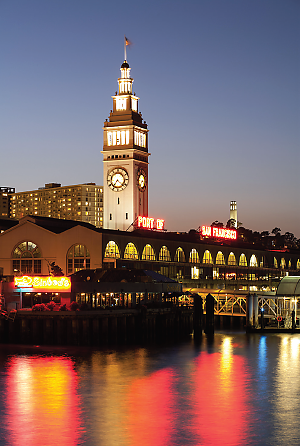Key Sights Reflect City’s Dependence on the Sea
Abstract
The Embarcadero, separating the city from the bay, contains two popular tourist sites—Fisherman’s Wharf and the Ferry Building. The former is tumultuous and entertaining, the latter is more laid back.
The Embarcadero is an embankment that flanks the east and northern rims of San Francisco and separates it from its namesake bay.

San Francisco’s Ferry Building hosts a food market whose offerings will make any gourmand’s mouth water.
In 1989, among the very few silver linings left behind after a devastating earthquake was severe damage to an unsightly double-decker freeway that ran along the Embarcadero and separated it from the rest of the city. After the quake, the freeway was torn down, and the Embarcadero emerged in unfettered splendor to entice tourists and natives alike to two of its major attractions—Fisherman’s Wharf and the Ferry Building. The former is located on the Embarcadero west of Pier 39; the latter is located on the Embarcadero at the foot of Market Street.
Fisherman’s Wharf is tumultuous and entertaining. You’ll find a salty breeze nipping at your face, smell the enticing aroma of sourdough bread, and hear barking seals competing with street musicians. You might have the dubious honor of being scared by a street performer who likes to hide behind eucalyptus branches and startle people as they walk by. There are also restaurants run by the same families for three generations, a store that sells items for lefties—say, coffee mugs and oven mitts and T shirts that say “I am a lefty, but I am always right.”
The Ferry Building, in contrast to Fisherman’s Wharf, is placid. It contains offices, a popular farmer’s market, and colorful food shops with names such as the Cowgirl Creamery’s Artisan Cheese Shop and the Hog Island Oyster Company. The former sells its own cheese and well-known cheeses from the United States and Europe. The latter supports small-scale organic food producers; it also sells oysters and clams raised on its own farm. Outside the Ferry Building, one can take ferries to destinations such as Angel Island (good for biking, hiking, and picnics) or Marin County (home to the picuresque artists’ mecca of Sausalito). The ferry rides offer spectacular panoramic views of San Francisco.
Even during the time of the California Gold Rush in the mid-19th century, the Embarcadero had a wooden ferry house on it. In 1898, the wooden house was replaced with a large steel-framed ferry building with a tall clock tower. It was designed by New York architect A. Page Brown in the Beaux Arts style. It was so well built that it survived the famous San Francisco earthquake of 1906. It was renovated in 2002 and reopened in 2003. It is a designated San Francisco landmark and listed on the National Register of Historic Places.
Fisherman’s Wharf also got its start in the mid-19th century, thanks to a man named Henry Meiggs. He was unscrupulous and scheming, according to the book Crab Is King: The Colorful Story of Fisherman’s Wharf in San Francisco and “got run out of town with a vengeful posse nipping at his heels.” Fortunately, in his wake, he left his wharf behind. Eventually it became a mooring for fishing boats and a promenade for sunbathers and swimmers. It had a museum where an “educated” pig played cards, a saltwater bathing emporium, and a place where visitors could try to climb a greased pole and claim a $5 gold piece on top.
In spite of its flamboyance, or perhaps because of it, Fisherman’s Wharf has been ranked in some surveys as the number-one tourist destination in San Francisco, even beating out the world-famous Gold Gate Bridge. ■
Information about Fisherman’s Wharf is posted at http://www.fishermanswharf.org. Information about the Ferry Building is posted at http://en.wikipedia.org/wiki/San_Francisco_Ferry_Building. City guides, a nonprofit volunteer organization, gives free walking tours of the Ferry Building. See http://www.sfcityguides.org/desc.html?tour=25 .



